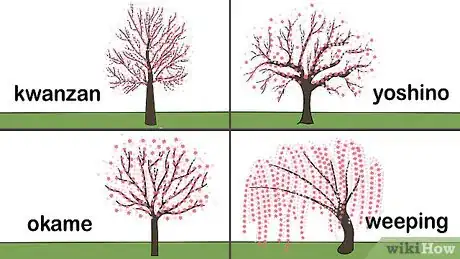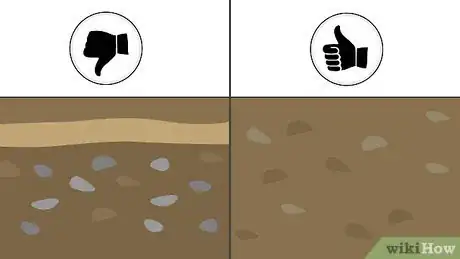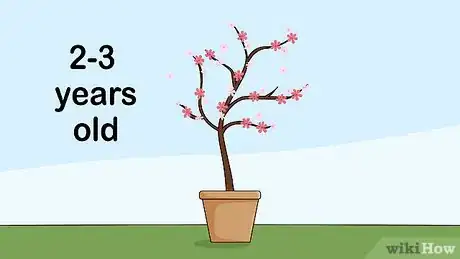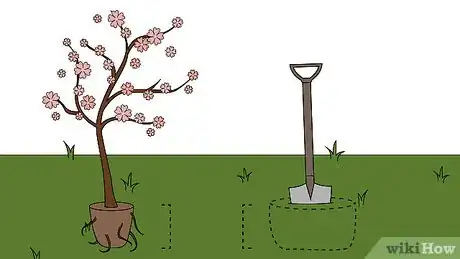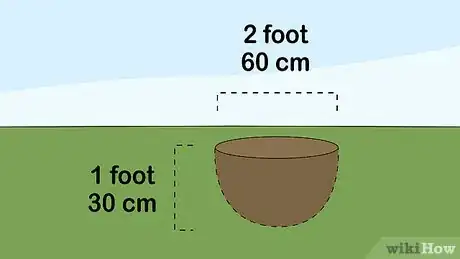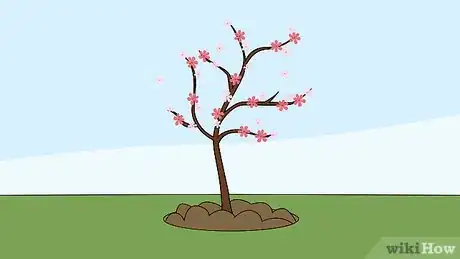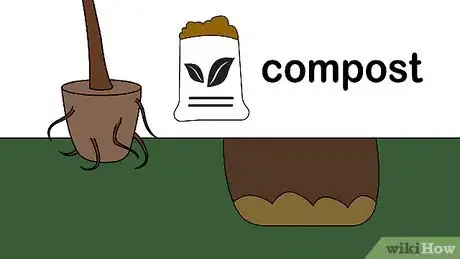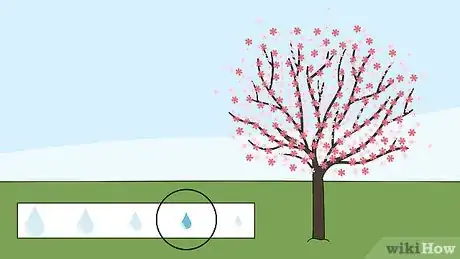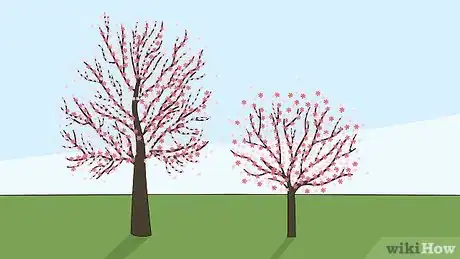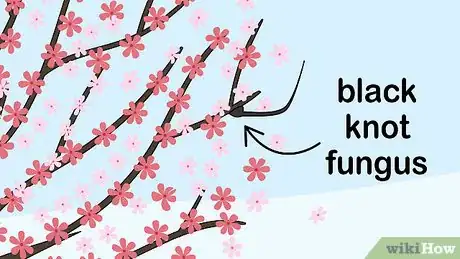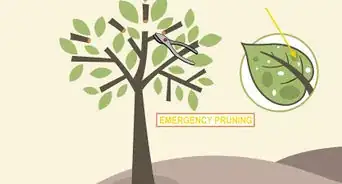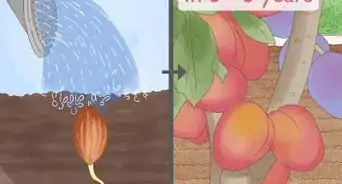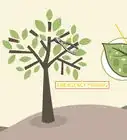This article was co-authored by Matt Bowman and by wikiHow staff writer, Sophia Latorre. Matt Bowman is a Gardener, Landscaper, the Owner of Georgia Farm to Table, and the Owner of Tradition Property Services in Atlanta, Georgia. With over 20 years experience, he specializes in organic gardening, landscape maintenance, handyman services, homecare services, and supplying Christmas trees. Matt earned a BA in Journalism from the University of Georgia.
There are 7 references cited in this article, which can be found at the bottom of the page.
wikiHow marks an article as reader-approved once it receives enough positive feedback. In this case, 95% of readers who voted found the article helpful, earning it our reader-approved status.
This article has been viewed 639,408 times.
Cherry blossom trees are beautiful and vibrant, but they're also finicky and hard to grow. The cherry blossom tree's name comes from the soft and pretty blossoms they produce, and range in color from hot pink to creamy white. If you'd like to grow your own cherry blossom tree, choose a consult a nursery or landscaper before beginning. Then, pick a sheltered spot with full to partial sun and rich, deep soil. Plant your tree, then feed, water, and stake it, before surrounding the root area with wood chips.
Steps
Selecting a Tree and Planting Location
-
1Choose the type of cherry blossom tree you want. There are actually a variety of different cherry blossom trees available, each with different features. The Yoshino cherry tree grows quickly and has wide-spreading branches, while the Okame cherry tree has a rounded appearance and is a bit smaller.[1]
- The Kwanzan cherry tree is a tall tree that provides enough space to walk beneath it and admire it's bunches of blooms.
- There are also several kinds of weeping cherry trees, and you can choose one by size, if you have a specific spot to fill.
-
2Pick a spot with full sun to partial shade. In order to blossom, your cherry tree will need lots of sunlight, so choose a spot that gets at least four hours of direct sunlight per day.[2] If possible, choose a spot that is elevated compared to the rest of your lawn or garden to keep cold air from settling around your cherry tree.[3]
- Cherry blossom trees grow best in USDA hardiness zones 5 through 8.[4]
Advertisement -
3Select a space with deep, fertile soil. The soil beneath your cherry tree should be rich and deep. It's important that the soil is moist, but well-draining. Cherry trees can adapt to several soil types, but do better in acidic than alkaline environments.[5]
-
4Procure a one- to two-year-old tree. Nurseries sell cherry blossom tree planting stock as young trees, rather than seeds. Choose a tree in the type you have selected that is one- to two-years-old and that has been grown in an environment similar to the one you plan to transfer the tree too (i.e. sun exposure, soil type).[6]
Planting Your Tree
-
1Plant your cherry blossom tree after the last frost. To ensure your new tree thrives, plant it after the last frost of the season. Do an Internet search to find the average frost dates based on your location.[7]
-
2Space your tree 10 to 20 feet (3 to 6 m) from other foliage. A cherry blossom tree needs lots of room to grow. Plant the tree 10 to 20 ft (3 to 6 m) from other trees, shrubs, flowers, or foliage. This also helps reduce the spread of pests or diseases between plants.
-
3Prepare a hole for the tree. Dig a 2 feet (0.61 m) by 2 ft (60.1 cm by 60.1 cm) hole that is 1 ft (30.5 cm) deep by in your chosen location. Layer a small amount of organic matter in the bottom of the hole.[8]
-
4Place your tree in the hole. Carefully put your young tree in the hole. Make sure the surrounding soil is level with the top of the roots of the tree. Add or remove soil from the bottom of the hole if necessary.[9]
-
5Fill the hole with soil. Mix organic matter in with the soil you removed from the hole and fill in the area around the cherry blossom tree. Level out the soil with the surrounding area and tamp it down firmly.[10]
-
6Stake the tree to the surrounding area. To reduce movement due to strong winds, use tree ties to anchor your tree to two tree stakes. Place the stakes opposite each other, 2-2.5 ft (60.1-76.2 cm) from the trunk of the tree. Attach one tree tie from each stake to the trunk of the tree, about one-third of the way up the trunk.[11]
-
7Water the tree thoroughly. Water the area thoroughly until moist to set the soil in place. Let the soil drain well, as cherry blossom trees don't do well when sitting in soggy areas.[12]
-
8Fertilize your tree after watering. Sprinkle all-purpose fertilizer around the roots of your cherry tree. Choose a granular kind, rather than a liquid, as it will slowly release nutrients into the soil that surrounds the roots of your tree.[13]
- To determine what type of fertilizer to use, pick up a soil test from any garden center. If your soil is deficient in any specific nutrients, like nitrogen, phosphorus, or magnesium, choose a fertilizer that will add more of that nutrient. Otherwise, just use a 10-10-10 all-purpose fertilizer.[14]
-
9Surround the root area with bark or wood chips. Cover the root area with bark, wood chips, or garden compost to protect the roots. Layer 2-3 in (5-7.5 cm) of the material in a 2-ft-wide (60.1-cm-wide) circle around the tree trunk. This helps protect the tree roots from extreme temperature changes.[15]
Caring for Your Tree
-
1Water only during a drought. Cherry blossom trees do not require much care after planting. They will receive enough water from the natural environment, so only water them during extremely dry periods of the summer. If the leaves are wilting or the soil has begun to crack, give your tree a long drink.[16]
-
2Avoid pruning your tree. There's usually no reason to prune your tree, but if you find it to be absolutely necessary, do so between May and August, which is when the tree is actively growing.[17]
-
3Fertilize your tree in the spring. Apply a general granular fertilizer to your tree once per year, in the spring. Sprinkle the granules around the base of the tree so nutrients can be absorbed through the root system.[18]
-
4
Controlling Pests and Diseases
-
1Look out for aphids. If you aren't able to see the little bugs, look out for curling leaves. Black cherry aphids leave behind secretions that infect the twigs and leaves of cherry blossom trees. Treat the tree with insecticide to remove the aphids.[21]
-
2Inspect the joints and branches of the tree. If you see small growths on the joints or branches (usually light brown in color), your tree may be suffering from black knot fungus. Remove the affected branches to prevent the disease from spreading to the rest of the tree.[22]
- To control fungal diseases, soak your pruning tools in alcohol after using them on an infected plant or tree.
- If you see branches in the spring or summer that don't have any leaves on them, it could indicate that branch is damaged.[23]
-
3Examine the leaves of the tree. Watch out for a gray or silver appearance of the leaves on your tree. This silver leaf fungus occurs when branches begin to die, so cut back diseased branches immediately.[24]
- Watch the bark, as well. If you see white, flaky scaling, for instance, it could indicate that there's a pest living in the tree.[25]
Expert Q&A
Did you know you can get expert answers for this article?
Unlock expert answers by supporting wikiHow
-
QuestionDo cherry trees need a lot of water?
 Maggie MoranMaggie Moran is a Professional Gardener in Pennsylvania.
Maggie MoranMaggie Moran is a Professional Gardener in Pennsylvania.
Home & Garden Specialist
-
QuestionHow long does it take for a cherry tree to produce?
 Maggie MoranMaggie Moran is a Professional Gardener in Pennsylvania.
Maggie MoranMaggie Moran is a Professional Gardener in Pennsylvania.
Home & Garden Specialist
-
QuestionCan you grow a cherry tree from a seed?
 Maggie MoranMaggie Moran is a Professional Gardener in Pennsylvania.
Maggie MoranMaggie Moran is a Professional Gardener in Pennsylvania.
Home & Garden Specialist
Warnings
- Watch the moss. Use a garden hose or hands to keep the moss of branches that can inhibit growth.⧼thumbs_response⧽
References
- ↑ http://www.southernliving.com/home-garden/gardens/growing-cherry-trees#growing0cherry-trees
- ↑ https://www.arborday.org/trees/treeguide/TreeDetail.cfm?ItemID=812
- ↑ https://www.theflowerexpert.com/content/mostpopularflowers/morepopularflowers/cherry-blossom
- ↑ https://www.thetreecenter.com/all-about-cherry-blossom-tree/
- ↑ https://www.theflowerexpert.com/content/mostpopularflowers/morepopularflowers/cherry-blossom
- ↑ https://www.theflowerexpert.com/content/mostpopularflowers/morepopularflowers/cherry-blossom
- ↑ http://www.express.co.uk/life-style/garden/457845/How-to-plant-a-winter-flowering-cherry-tree-to-brighten-up-your-garden
- ↑ https://www.lovethegarden.com/plant-finder/trees/flowering-cherries
- ↑ https://www.lovethegarden.com/plant-finder/trees/flowering-cherries
- ↑ https://www.lovethegarden.com/plant-finder/trees/flowering-cherries
- ↑ https://www.lovethegarden.com/plant-finder/trees/flowering-cherries
- ↑ https://www.lovethegarden.com/plant-finder/trees/flowering-cherries
- ↑ https://www.lovethegarden.com/plant-finder/trees/flowering-cherries
- ↑ Matt Bowman. Gardener & Owner, Tradition Market & Garden. Expert Interview. 21 April 2020.
- ↑ https://www.lovethegarden.com/plant-finder/trees/flowering-cherries
- ↑ https://www.lovethegarden.com/plant-finder/trees/flowering-cherries
- ↑ https://www.lovethegarden.com/plant-finder/trees/flowering-cherries
- ↑ https://www.lovethegarden.com/plant-finder/trees/flowering-cherries
- ↑ https://www.thetreecenter.com/all-about-cherry-blossom-tree/
- ↑ https://www.theflowerexpert.com/content/mostpopularflowers/morepopularflowers/cherry-blossom
- ↑ https://www.thetreecenter.com/all-about-cherry-blossom-tree/
- ↑ https://www.thetreecenter.com/all-about-cherry-blossom-tree/
- ↑ Matt Bowman. Gardener & Owner, Tradition Market & Garden. Expert Interview. 21 April 2020.
- ↑ https://www.thetreecenter.com/all-about-cherry-blossom-tree/
- ↑ Matt Bowman. Gardener & Owner, Tradition Market & Garden. Expert Interview. 21 April 2020.
About This Article
To grow a cherry blossom tree, start by getting a young tree that's 2-3 years old from a nursery. Once you have your tree, plant it in a sunny spot that has deep, fertile soil. Tie the tree to some stakes in the ground to protect it from strong gusts of wind until it gets more established. After you plant your tree, don't worry about watering it regularly unless you experience a drought. To help your cherry blossom grow healthy and strong, apply a general fertilizer every spring. To learn how to plant a cherry blossom in the ground, scroll down!
